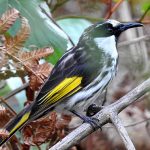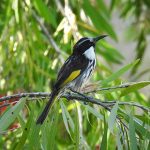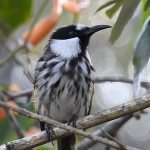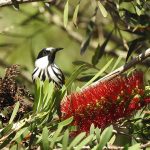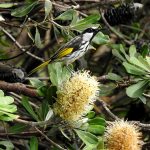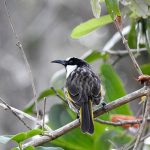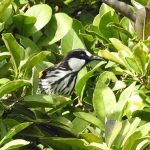WHITE-CHEEKED HONEYEATER
The White-cheeked honeyeater is a striking bird, easily recognisable by its bold black and white plumage. Its most distinctive feature is the bright white cheek patch that stands out against its glossy black head. The rest of its body is a mix of black, white, and grey, with a splash of yellow on the wings and tail. This contrast makes it quite a sight as it flits through the foliage. They are known for their acrobatic flight, often seen darting and weaving through vegetation with remarkable agility.
These honeyeaters are primarily found along the eastern and south-western coasts of Australia. They range from east of the Great Divide in Queensland through coastal New South Wales, becoming scattered south to Jervis Bay. They also occurs in south-western Western Australia and from Israelite Bay, east of Esperance, to the Murchison River in Kalbarri National Park.
They inhabit a range of environments, from coastal heathlands and forests to woodlands and urban gardens. They are particularly fond of areas with dense undergrowth and flowering plants, which provide both food and shelter. They are highly social birds, often seen in small flocks, especially outside the breeding season.
The White-cheeked honeyeater is known for its lively and varied vocalisations. It has a repertoire of calls, including sharp, metallic notes and a melodious, warbling song. These vocalisations are used for communication between mates, declaring territory, and alerting others to the presence of predators.
As its name suggests, the White-cheeked honeyeater primarily feeds on nectar, which it extracts from a variety of flowering plants using its long, curved bill. It also supplements its diet with insects and spiders, which provide essential proteins, especially during the breeding season. They play a crucial role in pollination, as they transfer pollen between flowers while feeding on nectar.
Breeding season for the White-cheeked honeyeater typically occurs from July to December, although this can vary depending on environmental conditions. The female builds a small, cup-shaped nest made of bark, grass, and spider webs, usually hidden in dense foliage. She lays two to three eggs, which she incubates for about two weeks. Both parents are involved in feeding the chicks once they hatch.
In the wild, White-cheeked honeyeaters can live for several years, although exact lifespan data is limited. Like many small birds, their longevity is influenced by factors such as predation, habitat quality, and food availability.
The White-cheeked honeyeater is currently listed as “Least Concern” by the IUCN, indicating that it is not at immediate risk of extinction. However, habitat destruction and fragmentation pose ongoing threats to its populations, highlighting the importance of conservation efforts to preserve their natural habitats.
The White-cheeked honeyeater is not just a visual marvel but also an integral part of Australia’s ecosystems. Its presence highlights the rich biodiversity of the regions it inhabits, reminding us of the importance of preserving these natural landscapes for future generations.

